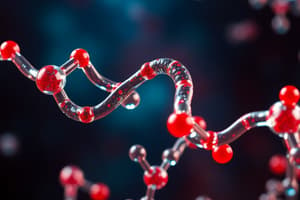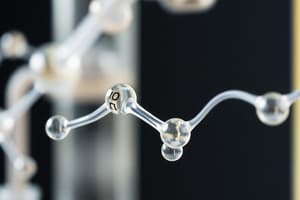Podcast
Questions and Answers
What is the primary role of ligases in biochemical reactions?
What is the primary role of ligases in biochemical reactions?
- They transport substrates across membranes.
- They catalyze degradation reactions.
- They synthesize various bonds coupled with ATP breakdown. (correct)
- They inhibit enzyme activity.
Which property allows enzymes to be reused multiple times in reactions?
Which property allows enzymes to be reused multiple times in reactions?
- Their ability to form ES complexes.
- Low turnover number.
- High specificity for substrates.
- Not being consumed in the reaction. (correct)
What factor primarily affects the rate of enzyme-catalyzed reactions according to enzyme kinetics?
What factor primarily affects the rate of enzyme-catalyzed reactions according to enzyme kinetics?
- Substrate specificity.
- Activation energy. (correct)
- Enzyme concentration.
- The presence of ligands.
How do enzymes lower the activation energy of a reaction?
How do enzymes lower the activation energy of a reaction?
What can inhibit the activity of an enzyme?
What can inhibit the activity of an enzyme?
What is the effect of increasing temperature on enzyme activity, up to a certain point?
What is the effect of increasing temperature on enzyme activity, up to a certain point?
Which of the following statements is true regarding enzyme specificity?
Which of the following statements is true regarding enzyme specificity?
How do cofactors influence enzyme activity?
How do cofactors influence enzyme activity?
What part of the electromagnetic spectrum corresponds to visible light that the human eye can detect?
What part of the electromagnetic spectrum corresponds to visible light that the human eye can detect?
What role does color play in consumer perception of food quality?
What role does color play in consumer perception of food quality?
Which of the following colorants is categorized as a certified dye?
Which of the following colorants is categorized as a certified dye?
What is a potential drawback of using turmeric as a natural color in food?
What is a potential drawback of using turmeric as a natural color in food?
How does color influence flavor perception in consumers?
How does color influence flavor perception in consumers?
Which natural color is used specifically for pickles and soft drinks?
Which natural color is used specifically for pickles and soft drinks?
Which of the following is an example of a colorant that is exempt from certification?
Which of the following is an example of a colorant that is exempt from certification?
What is a limitation of natural food colors compared to artificial ones?
What is a limitation of natural food colors compared to artificial ones?
Why are colors important when evaluating the freshness of food?
Why are colors important when evaluating the freshness of food?
Which of the following natural colors is derived from insects?
Which of the following natural colors is derived from insects?
What is a major reason for the limited use of natural food colors in products?
What is a major reason for the limited use of natural food colors in products?
What is one way in which colors can improve the appeal of food products?
What is one way in which colors can improve the appeal of food products?
How does color perception relate to sweetness in food products?
How does color perception relate to sweetness in food products?
Which pigment is NOT listed as a permitted natural color in India?
Which pigment is NOT listed as a permitted natural color in India?
What characteristic of natural food colors can affect their stability during processing?
What characteristic of natural food colors can affect their stability during processing?
What color is riboflavin commonly used to impart in food products?
What color is riboflavin commonly used to impart in food products?
What happens to the rate of enzyme-catalyzed reactions as temperature continues to increase beyond a certain point?
What happens to the rate of enzyme-catalyzed reactions as temperature continues to increase beyond a certain point?
What is the optimum pH value for an enzyme?
What is the optimum pH value for an enzyme?
Which factor primarily dictates the changes in reaction rate when varying enzyme concentration?
Which factor primarily dictates the changes in reaction rate when varying enzyme concentration?
Why do extreme changes in pH cause enzymes to denature?
Why do extreme changes in pH cause enzymes to denature?
What initially occurs when temperature increases in an enzyme-catalyzed reaction?
What initially occurs when temperature increases in an enzyme-catalyzed reaction?
At what point can substrate concentration no longer influence the rate of reaction?
At what point can substrate concentration no longer influence the rate of reaction?
How do small changes in pH affect enzymes compared to extreme changes?
How do small changes in pH affect enzymes compared to extreme changes?
What occurs to weak hydrogen and ionic bonds in enzymes when temperature rises significantly?
What occurs to weak hydrogen and ionic bonds in enzymes when temperature rises significantly?
Which statement accurately describes the reactivity of sugars?
Which statement accurately describes the reactivity of sugars?
What is a potential undesirable effect of the Maillard reaction?
What is a potential undesirable effect of the Maillard reaction?
How can thermal treatment affect the color of foods?
How can thermal treatment affect the color of foods?
What is suggested about the mechanism of non-enzymatic browning?
What is suggested about the mechanism of non-enzymatic browning?
Which factor does NOT influence the Maillard reaction?
Which factor does NOT influence the Maillard reaction?
What outcome is associated with toasting bread?
What outcome is associated with toasting bread?
Which aspect is NOT typically evaluated in color change during non-enzymatic browning?
Which aspect is NOT typically evaluated in color change during non-enzymatic browning?
What effect does raising the temperature have on the Maillard reaction?
What effect does raising the temperature have on the Maillard reaction?
Flashcards are hidden until you start studying
Study Notes
Ligases
- Catalyze the synthesis of various bonds, primarily C-X bonds, using energy from substrates like ATP.
Properties of Enzymes
- Exhibit high specificity for their substrates, catalyzing only one particular reaction.
- Remain unchanged during reactions and can be reused.
- Form enzyme-substrate (ES) complexes when they react with substrates.
- Require only small amounts to catalyze large quantities of substrates.
- Operate quickly, having high turnover numbers, converting many substrate molecules per unit time.
- Affected by changes in temperature and pH.
- Many require cofactors to function.
- Can be slowed down or stopped by inhibitors.
Functions of Enzymes
- Degradation reactions (catabolic).
- Synthesis (anabolic).
- Digestion.
- Protection.
Enzyme Kinetics and Reactions
- Studying enzyme kinetics reveals catalytic mechanisms, metabolic roles, activity control, and potential drug or agonist inhibition.
Activation Energy (Ea)
- Minimum energy needed for a chemical reaction to occur.
- Enzymes act as catalysts, lowering activation energy by changing the reaction pathway.
- Reduced activation energy increases the number of reactant molecules reaching sufficient energy to form products.
Factors Affecting Enzyme Activity
Temperature
- Increased temperature increases kinetic energy, leading to more collisions between molecules.
- Initially, this enhances reaction rate due to increased collisions between enzymes and substrates.
- However, excessive heat strains bonds within enzymes, causing active site shape changes and reduced substrate complementarity.
- This leads to a decrease in reaction rate as temperature rises further.
pH
- H+ and OH- ions interfere with hydrogen and ionic bonds maintaining enzyme structure.
- Enzymes have optimal pH values where their active site conformation best complements their substrate.
- Deviation from the optimal pH reduces reaction rate.
- Extreme pH changes can denature enzymes, permanently disrupting their function.
Concentration
- Changing enzyme and substrate concentrations influences reaction rates.
- Increasing concentration of a limiting factor boosts the reaction rate until saturation is reached.
- As reactions proceed, substrate depletion lowers reaction rates.
- Initial Reaction Rate represents the maximum rate achievable in experimental conditions.
- Increasing substrate concentration increases the rate until a plateau is reached where it becomes nonlimiting.
Maillard Reaction
- Reaction between reducing sugars and free amino acids, common during heating and storage of foods.
- Produces both desirable and undesirable products:
- Desirable: Caramel aromas, golden brown colors.
- Undesirable: Food darkness, off-flavor development, loss of lysine.
- Significantly reduces the nutritional value of food.
- Toasting can halve the protein efficiency ratio of bread.
Browning Measurement
- Measured by increased absorbance at 420 and 560 nm using reflectance colorimetry, indicating colored substance formation.
Kinetics of Nonenzymatic Browning
- First-order and zero-order models are employed to evaluate browning development.
- Complex kinetics involving browning and pigment degradation require multifaceted models.
- First-order kinetics is suggested for pigment destruction during thermal treatment.
- A two-stage model is proposed:
- Zero-order color formation.
- First-order pigment destruction.
- Increased temperature accelerates browning, increasing kinetic constants associated with color formation.
Factors Controlling Maillard Reaction Products
- Temperature, pH, moisture level (Aw), oxygen, metals, phosphates, sulfur dioxide, and inhibitors influence browning.
- Higher temperature and pH accelerate the Maillard reaction.
Food Color
- Reflects or emits different quantities of energy at wavelengths stimulating the retina, creating color perception.
- Visible light encompasses wavelengths between 380-770 nm.
- Color perception plays a significant role in influencing consumer purchasing decisions.
- Color is associated with quality and maturity in foods (e.g., redness of meat signifies freshness).
- Color influences flavor perception:
- Red drinks are expected to have strawberry or cherry flavors.
- Yellow drinks are associated with lemon.
- Green drinks are associated with lime.
- Color can affect perceived sweetness.
- Many food pigments are unstable during processing and storage.
Natural Colors
- Pigments derived from seeds, fruits, vegetables, algae, insects, and flowers.
- Examples and uses of natural colors are extensively listed in the provided text.
Permitted Natural Colors in India
- The Prevention of Food Adulteration Act, 1954 and associated rules permit the use of several natural colorants.
Limitations of Natural Food Colors
- Some natural colors have their flavors that can alter final product taste.
- Color retention can be affected by high temperatures.
- Some may cause allergic reactions.
- Natural colors are generally more expensive than artificial ones.
- Natural ingredient scarcity can occur.
Studying That Suits You
Use AI to generate personalized quizzes and flashcards to suit your learning preferences.



